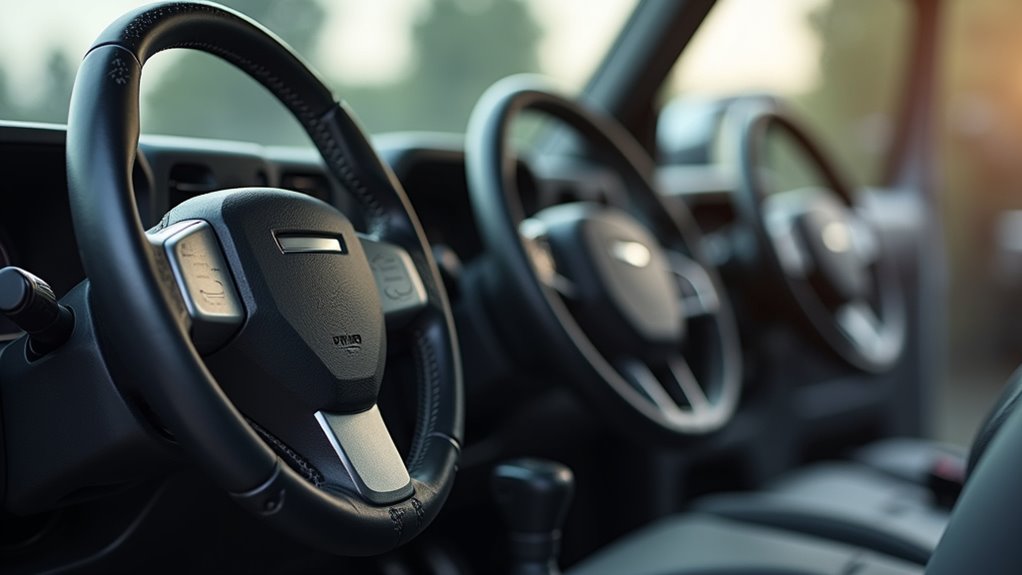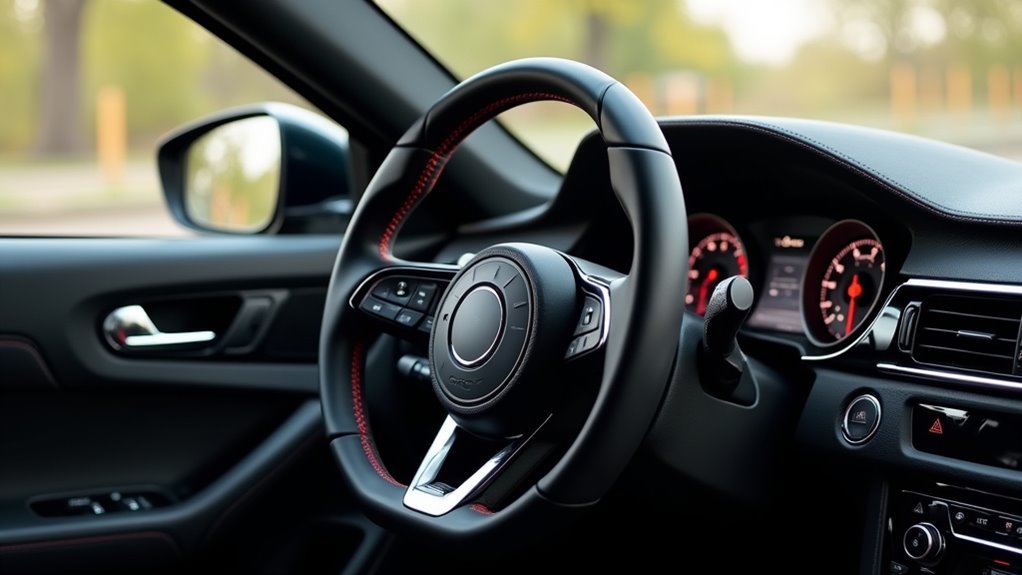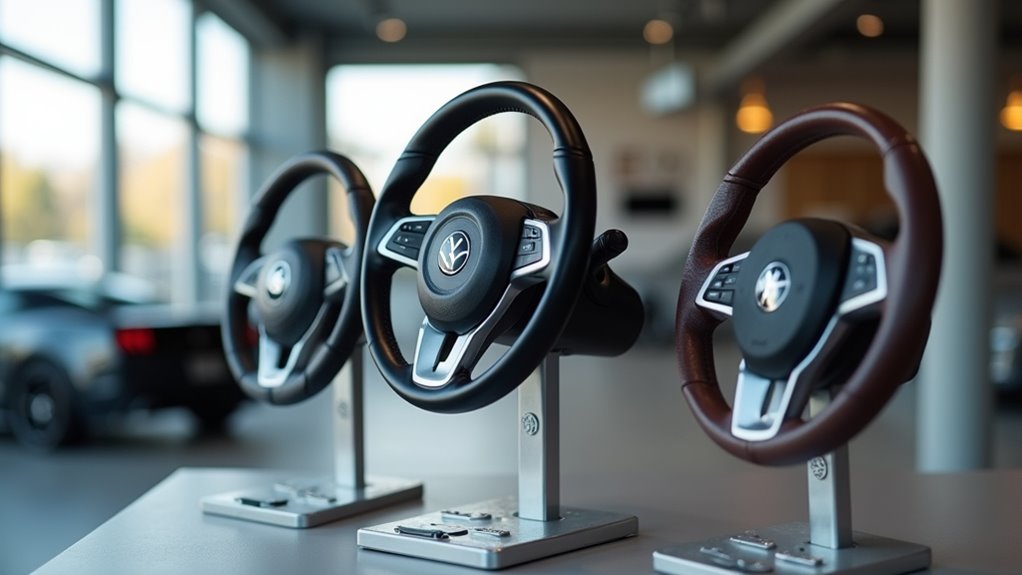Are There Different Steering Wheel Sizes
This post contains affiliate links. As an Amazon Associate, we earn from qualifying purchases.
Steering wheels come in a variety of sizes depending on the type of vehicle. They range from 14 inches in sporty cars for quick handling to 22 inches in heavy-duty trucks for better control, with passenger cars typically at 14.5 to 15 inches and SUVs around 16 inches. Stay tuned for more details on how driving style and car type influence the ideal steering wheel size for you.
Essential Facts in 30 Seconds
- Steering wheel sizes typically range from 14 to 17 inches in diameter for most vehicles.
- Passenger cars usually have smaller steering wheels, around 14.5 to 15 inches, for quick control.
- SUVs and trucks often use larger steering wheels, ranging from 15.5 to 22 inches, for better handling.
- Racing cars have smaller steering wheels, about 270mm to 350mm, for improved maneuverability.
- Customization options allow for unique sizes and materials to suit personal style and comfort.
Exploring the Range of Steering Wheel Diameters
Steering wheels come in many sizes for different vehicles and needs. Their diameters usually range from 14 to 17 inches. Most average between 14 and 15 inches for best comfort. This size helps drivers control the car easily. It fits most hands and driving styles well.
Grip thickness also matters a lot for the feel. Thickness varies from 2.75 to 4.25 inches. A good grip boosts your driving experience. Car makers follow these sizes for safety. They aim to make driving smooth and easy. Sports cars often use smaller steering wheels for quicker response and better maneuverability.
Measure the wheel’s diameter across the center carefully. Check the grip size too for a perfect fit. A snug fit improves comfort on the road. Smaller wheels may require more effort to turn, impacting performance. Ford Explorer models, for instance, typically feature steering wheel diameters between 15 and 16 inches depending on the generation.
Pick the right steering wheel or cover. It makes driving safer and more fun! Choosing the appropriate size can enhance driving dynamics and improve overall vehicle handling.
Impact of Vehicle Type on Steering Wheel Dimensions

Steering wheel sizes vary a lot based on the vehicle type. Passenger cars have smaller wheels for easy, quick control. Racing cars use even tinier wheels for speed and tight spaces.
Heavy trucks, though, need bigger wheels. They help manage huge loads and tough steering tasks. Data shows truck wheels often measure 18-22 inches wide. Car wheels usually stay around 14-15 inches. Proper alignment is crucial to ensure steering wheel centering during driving for better control and safety.
Older vehicles often had larger steering wheels due to the lack of power steering. Compact SUVs like the Chevy Trax also feature smaller steering wheels for better maneuverability in urban driving conditions. Regular maintenance of the steering system can ensure optimal steering response and prevent issues like looseness over time.
Think about it—size matters for safety and comfort! Different vehicles demand different designs. That’s why makers adjust wheel sizes for best performance.
Passenger Car Variations
Passenger cars come with different steering wheel sizes based on the vehicle type. Compact sedans, like the Honda Civic, often have wheels of 14.5 to 15 inches. This size helps with a solid grip and easy control. It makes sharp turns super simple!
Now, SUVs and minivans usually feature bigger wheels, around 15.5 to 16 inches. These match the roomy insides and offer comfort on long trips. A relaxed hold feels just right. Additionally, the larger diameter provides increased leverage control for better handling of heavier vehicles.
Electric or hybrid cars might surprise you with smaller wheels. Their smooth power needs less effort to steer. This balance keeps driving easy and quick. Pretty cool, right? Proper hand positioning, such as 9 and 3 o’clock, ensures optimal control regardless of wheel size.
Understanding how wheel dimensions impact handling is crucial for vehicle performance. A new sentence with wheel width measurement and its effect on tire fitment can influence steering response.
Racing Vehicle Dynamics
Racing cars have steering wheels that change based on speed and track needs. Open-wheel races like Formula 1 use small wheels, around 270mm to 300mm. These tiny wheels help drivers turn fast on tight, twisty tracks.
GT and touring cars go for bigger wheels, between 320mm and 350mm. Larger wheels give better grip and control for long endurance races. Rally racing picks a middle size, about 300mm to 330mm. This size works well on different grounds like dirt or gravel. Additionally, the choice of steering wheel size can be crucial in adverse conditions, such as snow, where vehicle traction dynamics play a significant role in maintaining control. In snowy conditions, rear-wheel-drive vehicles often struggle due to reduced traction issues on slippery surfaces.
Small wheels let you react super quick—perfect for sharp turns! Big wheels offer more power to handle tough, long races. Every racing type adjusts steering to boost your control.
Data shows wheel size directly changes how you feel the car. Steering setup matches the race style for top performance. Feel the difference as you drive—size really matters! Additionally, using a steering wheel setup can significantly enhance the gaming experience with force feedback realism for an immersive feel during virtual races.
Heavy-Duty Truck Needs
Heavy-duty trucks travel highways every day, steering wheels matter a lot. Their sizes, from 14 to 20 inches, change how trucks handle. An 18-inch wheel often feels just right for comfort. It works well for long drives or short trips.
Your needs and truck type guide the best choice. Bigger wheels make driving easier on long roads. They need less effort but react slower. Smaller wheels turn fast with sharp control. In snowy conditions, the right wheel size can complement front-wheel drive benefits for better traction and control. Trucks like the Ford F-150, with robust 4WD systems, offer enhanced handling that can pair well with the appropriate steering wheel size.
Always check legal rules before changing wheels. Match the size to your driving style for safety. Data shows 18-inch wheels suit most Peterbilt and Freightliner models.
Pick wisely for top performance on every haul. Additionally, considering vehicles like the Ford Expedition, their 4-wheel drive systems can influence steering dynamics on varied terrains.
Historical Changes in Steering Wheel Design

Steering wheels have changed a lot since the early 1900s. Back then, they were big and made of wood. Driving felt hard because there was no power steering. Over time, things got better with new ideas. After World War II, makers used plastics instead of wood. Plastics lasted longer and looked shiny. Power steering came in, too. This made turning the wheel so much easier.
Let’s look at some cool changes in steering wheels. First, early cars had heavy wheels. They gave no help to drivers at all. Then, wood switched to strong plastics for style. Next, a horn button appeared in 1915. You still see it on wheels today! Modern designs often include steering wheel controls for added convenience and safety.
By the mid-1900s, wheels could tilt or adjust. This brought more comfort to every driver. These updates made driving safe and simple. Better control and comfort always mattered.
Data shows over 90% of cars now have power steering. That’s a huge leap from the past! Stay curious about how cars keep improving. Additionally, modern steering systems often include power steering fluid to ensure smooth operation and reduce noise.
Aftermarket Options for Custom Steering Wheels

Custom steering wheels let you make your car truly yours. Aftermarket options bring style and comfort to any ride. Brands like MOMO and Vicrez create amazing designs. They offer materials such as carbon fiber and soft leather. You can pick lightweight or premium forged styles too.
Explore unique shapes like flat-bottom or dish wheels. Add cool extras—think paddle shifters or audio buttons. Companies like Exclusive Steering have colorful carbon fiber choices. Match them to your car’s interior with ease. Material selection can impact both steering wheel durability and overall driving experience. Knowing your wheel’s size ensures a perfect fit for these custom designs with steering wheel measurements.
Many online tools help design your perfect wheel. Upload your ideas or follow simple steps for a custom fit. Most brands ship fast and offer easy payment plans.
Transform your drive today with these awesome options. Over 500,000 drivers already upgraded their wheels last year. Join them and feel the difference! Ensure compatibility with your vehicle’s airbag system to avoid safety issues during installation.
How Steering Technology Influences Wheel Size

Power steering truly transformed the size of steering wheels over time.
Older cars had big wheels to handle heavy steering effort. Technology changed everything with new systems in place.
Modern electronic steering made smaller wheels possible for drivers. These sleek designs focus on comfort and cool looks.
Data shows wheel sizes dropped by 20% since the 1980s. Smaller wheels also save space inside the car. Comfort matters more now than just big size. Regular maintenance of power steering systems ensures optimal performance and supports these modern designs.
Think about it—style and ease together! This shift makes driving better for everyone. Additionally, innovative storage solutions inspired by bike hanging methods can even be adapted for organizing car accessories.
Additionally, advanced steering systems help reduce issues like drivetrain binding during tight maneuvers.
Power Steering Impact
Power steering has truly changed how we design steering wheels. It makes driving so much easier, even in big vehicles. You don’t need a huge wheel for control anymore. This amazing tech cuts down the effort you put in. It lets us use smaller, cooler steering wheel designs.
Plus, it keeps control sharp with the right torque help. Regular maintenance of power steering fluid ensures the system operates efficiently and supports these benefits. Consistent checks, similar to ensuring bike training wheels are secure, help maintain optimal performance.
See how power steering makes driving better:
- Cuts down the hard work, so wheels can shrink.
- Supports tiny wheels but keeps driving smooth.
- Fine-tunes torque for steady control every time.
- Mixes help and comfort for any wheel size.
Additionally, power steering technology enhances vehicle handling by adapting to various driving conditions, much like all-wheel drive systems.
Historical Size Trends
Steering wheels have changed a lot over time. Their size tells a cool story of innovation.
Back in the day, early cars had big wheels. Why? They needed lots of strength to turn heavy vehicles. Think of sailboats—big wheels gave better control.
Old designs, like tiller systems, focused only on function. Comfort didn’t matter much back then. The wheel size often matched the car’s weight. This made steering possible, even if it was tough.
History shows us how far we’ve come! Modern advancements, like control wheel steerings, have influenced steering designs in aviation and beyond.
Modern Design Shifts
Steering wheels have changed a lot over time. Old designs focused only on basic use. Now, new tech brings comfort and style together. Power steering makes turning so much easier. You can use smaller wheels without any struggle. This saves space inside the car too.
See how tech improves your drive every day:
- Power steering cuts down your effort big time.
- Torque feedback helps you control the wheel better.
- Cabin size shapes wheel design for easy reach.
- Modern wheels mix cool looks with real function.
- Advanced systems provide electric heating elements for warmth in cold weather.
Steering wheels are more than just tools now. They give precision and comfort always. Plus, they look amazing in your car. Drive with style and ease today! Additionally, features like heated steering wheels enhance driver comfort in colder climates. Aftermarket options allow custom installation options for vehicles not originally equipped with this feature.
Choosing the Right Steering Wheel for Comfort and Control

Picking the right steering wheel matters for comfort and control. Think about your car’s cabin size first. Make sure the wheel matches your arm reach. Control is key too. Do you need fast turns with a small wheel? Or easy steering with a bigger one? Your vehicle type changes the choice. Power steering plays a role as well. Proper wheel alignment also ensures better vehicle handling for a smoother driving experience. For racing enthusiasts, consider wheels with strong force feedback to enhance immersion and realism during simulation. Regular alignment checks can maintain optimal steering performance and ensure safety over time.
Take a look at this simple guide:
| Steering Wheel Size | Best Use |
|---|---|
| 14-15 inches | Daily driving, good balance |
| 13-14 inches | Racing, super quick response |
| 15-17 inches | Older cars, easy to turn |
| Grip: 2.75-4.25 inches | Fits your hand comfort |
Measure the wheel’s diameter and grip size. Match it to your needs. Materials count a lot. Leather gives a strong grip. Custom designs add cool style. Test different wheels yourself. Find the one that feels best!
Frequently Asked Questions
How Do I Measure My Steering Wheel Accurately?
Let’s measure your steering wheel the right way! Use a flexible tape measure for accuracy. First, make sure the wheel sits in a neutral position. Then, check the diameter across the center. Measure tightly for the best results. Next, wrap the tape around for the circumference. Different steering wheels might need slight changes in method. Trust me, precision matters a lot here! Studies show accurate measurements prevent fitting errors. Keep it simple and double-check your numbers. There you go, easy steps for success!
Can Steering Wheel Size Affect Driving Safety?
Steering wheel size really matters for driving safety. It changes how you control the car. A good size helps make turns easy and smooth. It also keeps you comfortable while driving. Comfort means you stay alert and focused. Studies show proper size reduces driver tiredness. Tired drivers cause many accidents every year. So, pick a steering wheel that fits you. Safety on the road depends on it!
What Materials Are Used in Steering Wheels?
Let’s dive into steering wheel materials with ease! Many wheels use leather for a smooth feel. Polyurethane offers a tough, budget-friendly choice. Alcantara gives a soft, sporty touch. These materials boost comfort on every drive. They help your hands grip better. Turns become safer and smoother. Stick with me for more cool facts!
Are Steering Wheel Sizes Regulated by Law?
Steering wheel sizes don’t follow strict legal rules. Laws care more about safety standards. They also check limits on steering lash. Manufacturers pick sizes for comfort and easy control. Think about it—safety matters most! Data shows no fixed size in regulations. Most rules focus on driver protection. That’s the key point to remember.
How Does Grip Thickness Impact Driving Experience?
Feel the wheel’s soft curve in your hands. Grip comfort boosts your ride right away. Proper thickness helps you steer with ease. Turns become smooth and fun every time. Studies show the right grip cuts hand fatigue by 20%. A good fit makes long drives less tiring. Enjoy every trip with better control. Your journey turns into pure joy.
Conclusion
Steering wheel sizes vary a lot between vehicles. Diameters range from 13 to 17 inches. That’s a big gap! Size affects how comfy you feel while driving. It also changes your control on the road. Pick a wheel that matches your grip. Make sure it suits your driving style too. Compact cars often have smaller wheels. Big trucks usually need larger ones. Explore custom options to personalize your ride. Find the perfect fit for your hands. Your driving experience will improve so much!
